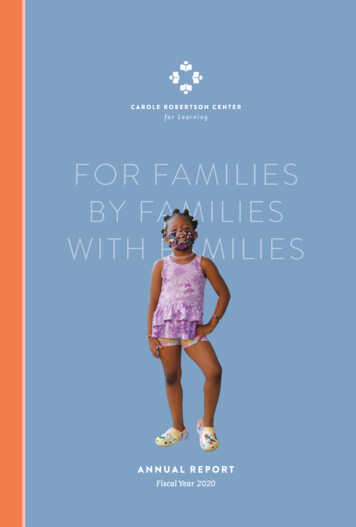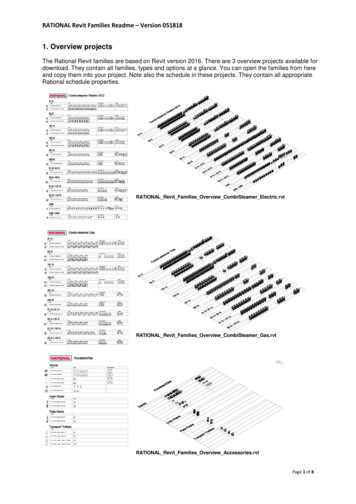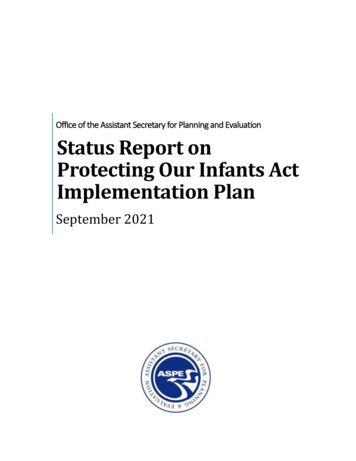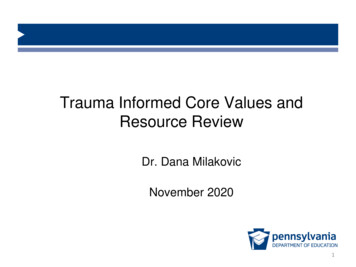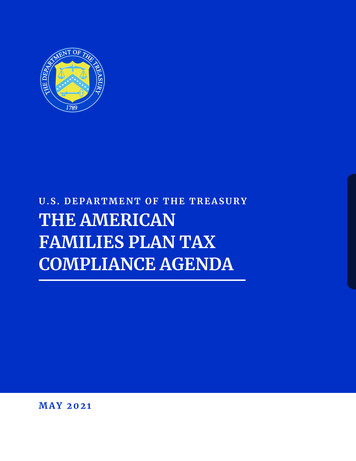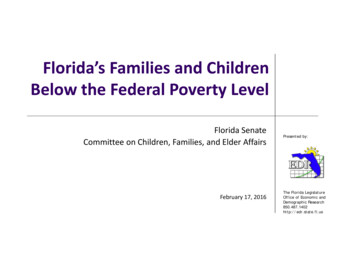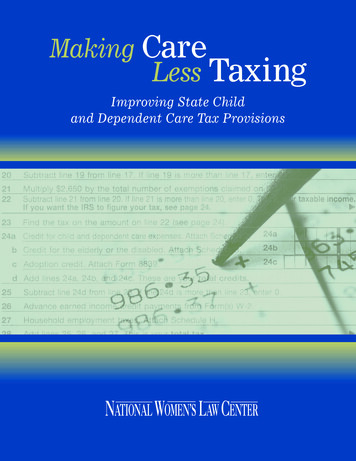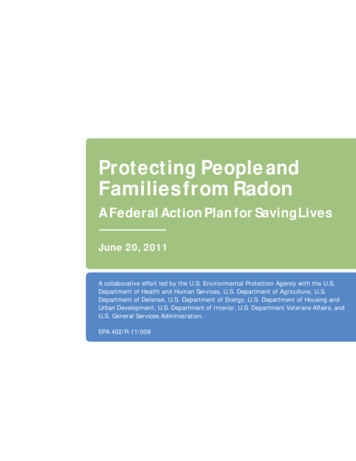
Transcription
Protecting People andFamilies from RadonA Federal Action Plan for Saving LivesJune 20, 2011A collaborative effort led by the U.S. Environmental Protection Agency with the U.S.Department of Health and Human Services, U.S. Department of Agriculture, U.S.Department of Defense, U.S. Department of Energy, U.S. Department of Housing andUrban Development, U.S. Department of Interior, U.S. Department Veterans Affairs, andU.S. General Services Administration.EPA 402/R-11/009
PROTECTING PEOPLE AND FAMILIES FROM RADONA FEDERAL ACTION PLAN FOR SAVING LIVESThe Federal Radon Action Plan (Action Plan) presents amulti-year approach to protecting public health, especiallyof families, by reducing the risk from radon exposure.The federal government’s policies and programs directlyor indirectly have influence over an estimated 7.5 millionhomes, schools, and daycare facilities. An estimated onehalf million of these homes, schools and daycare facilitiespotentially have an elevated radon level.This Action Plan is the result of a collaborative effort led bythe U.S. Environmental Protection Agency (EPA) with theU.S. Departments of Health and Human Services (HHS),Agriculture (USDA), Defense (DOD), Energy (DOE), Housingand Urban Development (HUD), Interior (DOI), VeteransAffairs (VA) and the General Services Administration(GSA). Representatives of these agencies have metregularly since November 2010 to assess the government’scurrent activities to address radon risks and identify waysto increase the effectiveness of federal action to reducelung cancer risk from indoor radon exposure. The FederalRadon Action Plan Workgroup has focused on leveragingprograms and increasing the efficiency of radon-relatedactivities to have a greater impact on public health.Healthy People 2020 — a ten year, national agenda forimproving the health of all Americans — includes thefollowing objectives for radon risk reduction. Have an operating radon mitigation system in 3.1million (30 percent) of the estimated 9.2 million homeswith an elevated radon level. Increase to 100 the percentage of new single familyhomes constructed with radon-reducing features inhigh-radon potential areas.The Healthy People 2020 radon objectives demonstratethat exposure to elevated indoor radon levels is animportant national public health issue. Healthy People 2020also points to solutions: mitigate high radon levels andconstruct radon-resistant new buildings.The strategy for federal radon action presented hereoutlines actions federal agencies can take within existingresources and program capacities to advance the HealthyPeople 2020 radon objectives and launch an ambitiousnational effort to end all avoidable radon-induced lungcancer death. This Action Plan envisions unified federalaction as the catalyst to increased and more effective stateEPA 402/R-11/009and local activity, private and nonprofit sector engagementand voluntary individual action. Strategic federal actioncan demonstrate the importance, feasibility and value ofradon risk reduction in ways that spur radon partners andindividual Americans to action.The ultimate public health goal this Action Plan highlightsis the elimination of preventable radon-induced cancerthrough expanded radon testing of existing homes,mitigation of high radon levels within those homes, andradon-resistant new construction. This strategy lays a pathto achieving that goal and meeting the Healthy People 2020radon objectives.The ProblemRadon causes an estimated 21,000 lung cancer deaths inthe United States every year.1 Radon risk estimates arebased on extensive epidemiological studies, and there isconvincing evidence about its link to lung cancer. According to Dr. R. William Field, U.S. radon expert(University of Iowa), radon is the leading environmentalcause of cancer death in North America.2 Radon is the second leading cause of lung cancer afteractive smoking and the leading cause among nonsmokers.3o Smoking has a synergistic effect on radon-relatedlung cancer.o Source reduction from radon is the only way to protectnon-smokers from radon-related lung cancer. An estimated 88 percent of Americans do not knowthat radon is the second leading cause of lung cancer,according to survey data.4Many radon-induced lung cancer deaths are preventable. Testing for and mitigating high radon levels uses tested,time-proven, straightforward techniques. There is extensive knowledge on how to build new homesto resist radon intrusion.Many low- and middle-income Americans either cannot orwill not pay for radon mitigation. Without financial assistance, many low incomeAmericans do not have the financial resources tomitigate high radon levels.1
Without economic incentives, many middle incomeAmericans are not yet convinced of the value ofmitigating high radon levels.Because of recent housing booms, today there are morehomes in the United States with elevated radon levels thanever before.5Current RealityToo few homes, schools and daycare facilities are testedfor radon. An even smaller number are mitigated when highradon levels are found. Although the technical knowledgeexists to reduce radon risks, the United States has not yetachieved the level of voluntary action required to make areal impact on indoor radon exposure.Three fundamental — and interrelated — barriers preventwidespread, voluntary radon risk reduction: Limited public understanding of the gravity of the riskand the fact that the solution is proven and uses readilyavailable technology. Perceived high costs of mitigation and radon-resistantconstruction relative to the perceived increased valueat the time of resale. Limited nationwide availability of certified radonmeasurement and mitigation professionals.6Accordingly, there are three major and interrelatedopportunities for changing the status quo, dramaticallyreducing radon exposure, and preventing thousands oflung cancer deaths annually: Demonstrate the importance, feasibility and value ofradon testing and mitigation. Provide economic incentives to encourage those whohave sufficient resources to test and mitigate, andprovide direct support to reduce the risk for those wholack sufficient resources. Build demand for services from the professional,nationwide radon services industry.Radon risk is reduced when homes, schools, and daycarefacilities that test high for radon are mitigated, and whennew buildings are constructed using radon-resistanttechniques. Building owners, occupants, landlords andmanagers, architects, builders and many others can takeactions to reduce radon risk, but few localities mandateradon testing, mitigation or radon-resistant construction,and current levels of voluntary action are insufficient toaddress the risk.7EPA 402/R-11/009In existing homes, most radon testing and mitigationoccurs as part of a real estate transaction — less than 30percent of tested homes are tested outside of a real estatetransaction. Most homeowners explain their decisionnot to test for or mitigate high radon levels based onmisperceptions: the perceived high cost relative to lowreturn at the time of resale on the mitigation investmentand underestimating the seriousness of the health risk. Nostates require disclosure of radon risk during real estatetransactions; although in a limited number of states, realestate disclosure has become the norm.In renter-occupied homes, there is virtually nothinga renter can do to limit exposure to high radon levelsand there are no known requirements or incentives forlandlords to test or mitigate.In new construction, the small percentage of homesbuilt radon-resistant are the result of either a voluntarycommitment to a green building standard — and notall green building standards address radon — or alocal requirement to use radon-resistant constructiontechniques in high radon risk zones. Very few localitiesrequire radon-resistant construction in high risk zones.8Provisions that require radon-resistant new constructionin universally adopted building codes, such as theInternational Code Council’s construction codes, canaddress this issue; many localities and agencies use thesecodes to guide their construction specifications.In the case of schools and daycare facilities, there areno federal health and safety requirements for radon thataddress risks to occupant health. Few states and localitiesaddress radon in their requirements or guidance for schooland daycare construction and operation.The SolutionThe Federal Radon Action Plan presents a strategy forlaunching a transformation in public attitudes and behaviortowards radon risk in the United States. Key state, industryand nonprofit sector allies stand ready to build on thefederal strategy to create and sustain a national radon riskreduction campaign. The national campaign will increasepublic understanding of the risk; advance effectivenational, state and local radon policy; promote testing,mitigation and radon-resistant construction as standardpractice in green building, real estate and constructionindustries; and deliver financing and other incentives tohelp homeowners mitigate high radon levels. This nationalradon effort — led jointly by the federal government andkey national partners — will fundamentally change homebuilder, buyer and owner expectations and behavior, topromote testing in all American homes and mitigation ofhigh radon levels wherever they are found.2
Reducing risks posed by radon can be implemented aspart of a holistic approach to reduce the overall risk oflung cancer in the home. Since the lung cancer riskfrom high levels of radon is high for everyone, all people,whether they smoke or not, should test for and mitigatehigh levels of radon in their homes. In addition to reducingradon levels, smokers should quit smoking and familiesshould establish household rules against smoking tobaccoproducts in the home. This comprehensive approach canreduce risks from lung cancer and other diseases as wellas the synergistic risk from active smoking and radonexposure. Testing for and mitigating high levels of radon,quitting smoking, and eliminating exposure to secondhandsmoke are the best ways to reduce the overall risk of lungcancer.public health risks and preventable illness. By extendingthe reach, scope and impact of existing programs, thefederal government can immediately reduce lung cancerrisk for occupants in the homes, schools and daycarefacilities the government owns, manages and administers;promote radon risk reduction in the homes, schools anddaycare facilities its programs influence; and advancepolicies to help homeowners, buyers and builders addressradon risk nationwide. Collectively, these actions have thepotential to represent a measurable and comparativelycost-effective federal approach to improving public healthand preventing cancer deaths.9Radon Risk Reduction: An Opportunity for theFederal FamilyThe federal approach to radon takes advantage of thegovernment’s unique ability to lead through demonstration,leverage programs across agencies to maximize theirbenefits, and use the broad visibility of government actionto drive public understanding and focus public activity.Federal agencies, departments, offices and programs mustrespond to Presidential and Congressional calls to addressThe Federal Family’s Power to Save Lives:Leadership, Leverage and VisibilityELIMINATING PREVENTABLE RADON RISKJAN 2011 – JAN 2015EnhancedNationalAwarenessRamped ion10 millionhomesmitigated6,500LIVESSAVEDBuild Demand for ProfessionalRadon IndustryAddress Financing &Incentive ProblemsDemonstrate Importance &Value of Radon Risk ReductionPhase 1FEDERAL FAMILY ACTIONEPA 402/R-11/009Phase 2ALLIED FEDERAL-PRIVATE-NON PROFIT ACTION3
LeadershipThe federal government has direct access to an estimatedfive million homes, schools and daycare facilities.10 Inaddition, the federal government has indirect access toan estimated 2.5 million homes through its financing andstandard setting programs.11 Federal programs that own,manage, administer, finance and develop policies forhomes, schools and daycare facilities can lead efforts toreduce lung cancer risk from radon by delivering, requiringand financing radon testing and mitigation, and promotingradon-resistant construction.LeverageThe federal government can leverage its programs thatfund activity in homes to reduce radon risks during homeassessment, renovation, retrofit, rehabilitation, repair andother home-based programs.VisibilityThe federal government can use its purchasing power andthe power of its unified voice to deliver a clear messageto help increase public understanding of the risk and thesimplicity of the solution, and build the market for certifiedradon testing, mitigation and radon-resistant constructionservices. Unified action addressing radon risk in federallyowned, managed and financed homes and promotingradon risk reduction nationally will stimulate the radonmitigation industry, help save jobs for the estimated 3,000certified radon professionals active today and create jobsfor new industry members. The federal government hasan unparalleled ability to deliver a consistent nationalmessage about the seriousness of the risk to accompanyits ramped-up action on radon.EPA 402/R-11/009PROTECTING LOW-INCOMEAMERICANSThe federal government has a unique opportunityto address radon risk in low-income communities.Most federal programs that own, manage andfinance housing or deliver home improvementsfocus on low-income homes. A significant proportionof the radon risk reduction that the federalgovernment can deliver and influence will protectthe lives of low-income Americans who wouldotherwise have no way to reduce their radon risk.Laying the Groundwork for Federal ActionIn November 2010, May and June 2011, federal leadersconvened to discuss ways the federal government canpromote radon risk reduction, determine a processfor capturing these commitments and implement thecommitments after the Action Plan’s release. The tableon page 5 presents a framework used to design a federalresponse to radon and identify strategies agencies canpursue to advance radon risk reduction on a national scale.4
FEDERAL GOVERNMENT ACTIONS TO REDUCE RADON RISK EPA, HUD, USDA, and HHS will collaborate on an interagency radon outreach initiative that builds on existing campaignsaddressing home-based risks and or healthy homes. DOD will develop a communications campaign to educate all personnel – living both on and off base – about the health risksassociated with radon exposure and solutions to address these risks.DEMONSTRATEthe importanceof radon riskreduction HUD will incorporate radon testing and mitigation into as many agency programs as possible to include public and otherassisted housing. HUD will prepare a plan within the next 18 months to collect radon test results as part of its ongoing inspection protocol ofpublic and assisted housing as the first step in conducting a baseline study of its housing stock. HHS will include radon in healthy homes activities (CDC National Center for Environmental Health). HHS will work to increase radon awareness among states participating in the National Comprehensive Cancer Control Program(CDC Division of Cancer Prevention and Control). HHS and EPA will explore including radon in environmental health tracking (CDC’s National Center for Environmental Health). HHS will update the current Toxicological Profile for Radon (Agency for ToxicSubstances and Disease Registry). DOE and HUD will promote radon awareness through their weatherization and healthy homes outreach. DOI will send a message on the hazards of radon to its approximately 70,000 employees. HUD’s Power Saver Loan Program will make radon mitigation an explicitly eligible/allowable expense within the 25% nonenergy related set-aside.ADDRESSFINANCEand incentiveissues to drivetesting andmitigation USDA will develop working agreements with nonprofits that can assist 504 home repair grantees and loan recipients infunding mitigation efforts whenever radon is found at or above the EPA 4 pCi/L action level. USDA will educate Rural Housing Guarantee Program lenders and State Housing Finance Authorities about radon risksand encourage the testing of existing homes in Zones 1 (high) and 2 (medium) areas. USDA will leverage financing through renovation/repair programs and essential community programs to test and mitigateradon in schools and daycare facilities. VA will promote radon testing and mitigation through a comprehensive disclosure of the radon health risk to borrowers. VA will explore providing a radon mitigation cost set-aside through its Home Loan Guarantee program. EPA, HUD and USDA will engage the philanthropic community to support radon risk reduction in the context of theirsupport for local healthy homes programs. EPA and Treasury will work together to facilitate the deductibility of radon testing/mitigation costs within Health SpendingAccounts. DOD will review and update, as appropriate, the Unified Facility Criteria to reflect current standards for radon measurement,mitigation, and radon-resistant new construction for low rise buildings (e.g., multifamily, schools, daycare facilities). DOD will identify the universe of low-rise buildings in high radon potential areas (Zone 1) and, for those buildings notpreviously addressed, develop a testing and mitigation plan for those at or above the EPA 4 piC/L action level. EPA will invest in new standards of practice for school measurement and mitigation, multifamily mitigation, and qualityassurance. DOE will finish the radon study as part of the National Evaluation to determine whether the Weatherization AssistanceProgram (WAP) impacts radon levels in homes.BUILDDEMANDfor servicesfrom theprofessional,nationwideindustry DOE will test various remediation protocols to determine what level of effort is required when radon is discovered in a home orwhen the level rises after WAP services are delivered. DOE will add a healthy homes curriculum to WAP training requirements that includes radon identification and remediationprotocols. DOE will include training, described above, as part of DOE’s routine health and safety training such that every worker in theWAP network will be trained over the next 2 years. HUD’s Healthy Homes Production Program grantees will check for sources of radiation, such as from radon, as required byHUD’s Healthy Homes Rating Tool. Mitigation is required for high radon levels. USDA will collaborate with the Cooperative Extension Service (CES) to focus their testing efforts on new and existing RuralHousing financed properties. USDA will educate multifamily housing developers about radon risks and what construction mitigation strategies can be usedwhen radon is found. USDA will promote radon testing and mitigation through Rural Development Housing and Community Facilities Programs. DOI, through the National Park Service, will test approximately 5,000 residential units for radon. DOI, through the Bureau of Indian Affairs, will test approximately 3,500 residential units and 500 schools, and will work withTribes to increase awareness of the radon risk. GSA will explore testing for radon and mitigating high levels in childcare facilities through the Federal Real Property Program. GSA will promote professional radon services to federal tenants.EPA 402/R-11/0095
SOURCESU.S. Environmental Protection Agency. 2003. EPA Assessment of Risks from Radon in Homes. Accessed April 16, 2011.Available online at 03-003.pdf.1Field R.W. (2011). “Radon: An Overview of Health Effects.” In: Nriagu JO (ed.) Encyclopedia of Environmental Health,volume 4, pp.745-753. Burlington: Elsevier.23World Health Organization. 2009. Handbook on Indoor Radon: A Public Health Perspective.“Americans in the Dark About Lung Cancer.” Accessed April 19, 2011. National Lung Cancer Partnership. 2011. Availableonline at: mk.php?pid 1188&sid S2011042007190370S6NP&pr 1804.4Angell, W.J. 2008. “The US radon problem, policy, program and industry: achievements, challenges and strategies.”Oxford Journals, Radiation Protection Dosimetry, Vol 130, Issue 1: 8-13. Available at: ?keytype ref&ijkey oUK4il9FRACYAS5.5The National Environmental Health Association National Radon Proficiency Program (NEHA NRPP) and National RadonSafety Board (NRSB) offer independent certification and accreditation for radon professionals; many state radon programwebsites provide links to certified service providers.67“RRNC Codes by State.” Accessed April 13, 2011. http://www.epa.gov/radon/rrnc/code listing.html.Environmental Law Institute. 2004. Database Excerpt: Radon Laws. Database of State Air Quality Laws. Accessed April 13,2011. Available online at: http://www.afhh.org/hps/radondocs/eli database radon state laws.pdf.12.2 percent of new single family homes built during 2008 had radon-resistant features. Thirty-one percent of those homeswere built in Zone 1. National Association of Home Builders (NAHB). 2009. “Number of Homes Built with Radon-ResistantNew Construction.” National Association of Home Builders (NAHB) Research Center Survey of New homes Built During2008.8U.S. EPA estimates an average cost per life saved of 80,000 for radon-resistant new construction, and 400,000 formitigating existing homes. Unpublished EPA benefit-cost data (2004, updates); based on the Technical Support Documentfor the 1992 Citizen’s Guide to Radon (EPA 400-R-92-011, May 1992).910U.S. General Services Administration (GSA), 2009. “FY 2009 Federal Real Property Report.”U.S. Department of Housing and Urban Development (HUD). FHA Mutual Mortgage Insurance Fund. (Annual Report toCongress.) Information available at: www.expectmore.gov.11United States Department of Agriculture. Rural Housing Single Service Family Housing Loan Guarantees and Direct ServiceLoans. Information available at: www.expectmore.gov.Department of Defense. DOD Defense Housing. Information available at: www.expectmore.gov.Veteran Affairs. VA Home Loans. Information available at: www.expectmore.gov.EPA 402/R-11/0096
APPENDIX 1: OVERVIEW OF CURRENT FEDERAL ACTION ON RADONAGENCYCURRENT ACTION ON RADONU.S. Department ofAgriculture (USDA) USDA partnered with EPA on the Healthy Indoor Air for America’s Homes program in the mid 1990s, anational initiative through Cooperative Extension Systems to assist states with the measurement andmitigation of radon. USDA developed radon guidance for federal land managers, specifically “Rehabilitating AffordableRural Housing” and “A Guide for Financing Radon Mitigation to Reduce Exposure in Existing Housing.” USDA supported public outreach on radon through education programs, public newsletters, promotionof the Radon Poster Contest, and National Radon Awareness Week.U.S. Department ofDefense (DOD) DOD currently has an active program to test housing stock, and to mitigate if levels are found to be at orabove the EPA radon action level of 4 pCi/L. The DOD Unified Facilities Guide Specifications address radon testing and mitigation. Radon testing andmitigation are also incorporated into three sets of active DOD building criteria.U.S. Department ofEnergy (DOE) DOE is conducting a field study on the link between weatherization and radon levels in homes throughthe Weatherization Assistance Program. The Weatherization Assistance Program’s new Program Guidance permits Weatherization crews to testfor radon. Radon measures are addressed in DOE’s “Workforce Guidelines for Home Energy Upgrades,” releasedthrough Vice President Biden’s “Recovery Through Retrofit” Initiative.U.S. Department ofHealth and HumanServices (HHS) The Centers for Disease Control and Prevention (CDC) has co-authored every version of the Citizen’sGuide to Radon with EPA. The National Institutes of Health (NIH) have conducted research on radon, including occupational andresidential research on the health effects of indoor radon, and an updated analysis of radon exposuredata from miners. NIH contributed to the National Academy of Sciences’ Biological Effects of Ionizing Radiation, ReportsIV and VI (BEIR IV, BEIR VI), and participated in the North American Residential Radon pooling study. NIH gave testimony on radon health risk to the President’s Cancer Panel. The Office of the Surgeon General (OSG) issued a “National Health Advisory on Radon” in 2005, andincluded radon in its 2009 “Call to Action to Promote Healthy Homes.” OSG has coordinated with EPA on public service announcements highlighting the Surgeon General’s2005 advisory.U.S. Department ofHousing and UrbanDevelopment (HUD) HUD incorporated radon into its healthy homes strategic plan, Leading Our Nation to Healthier Homes.The HUD Office of Healthy Homes is seeking increased collaboration with other HUD offices thatoversee housing assistance and mortgage programs to promote radon testing and mitigation. A Radon and Mold Release Agreement (HUD-9548-E) is required in all sales contracts for HUD-acquiredsingle family properties. A HUD form discussing radon and home inspections (HUD-92564-CN) is required to be provided bymortgagees to prospective homebuyers at first contact for all new transactions involving single familyFHA mortgage insurance on existing property. The HUD Section 203(k) mortgage financing program is HUD’s primary tool for rehabilitating andimproving single family homes. The program allows home buyers to finance the purchase and repairor improvement of a home using a single mortgage loan. Reducing radon levels in a home is animprovement that can be financed through the Section 203(k) program.U.S. Department ofInterior (DOI) The U.S. Fish and Wildlife Service has a radon policy for measurement and mitigation for radonexposure in owned or leased buildings and non-public water sources. The U.S. Fish and Wildlife Service has a Hazard Communication Program which provides a frameworkfor providing health and safety information and training for special emphasis programs, including radon.U.S. Department of The VA Home Loan Guaranty program tends to be guided by HUD policy on radon testing and mitigation.Veterans Affairs (VA) VA is reviewing its real estate valuation/appraisal procedures to account for radon.EPA 402/R-11/0097
AGENCYCURRENT ACTION ON RADONU.S. EnvironmentalProtection Agency(EPA) EPA provides the scientific foundation on radon, and facilitates the development of technical guidance,protocols and standards needed for risk reduction. EPA provides 8 million in radon grants to states and tribes each year to fund state-wide radon riskreduction programs. EPA supports outreach and education campaigns, as well as partnerships with states, tribes, NGOs andthe radon services industry.U.S. General Services GSA conducts radon testing in all of its leased and new-owned buildings. If levels are found to be at orAdministration (GSA)above the EPA radon action level of 4 pCi/L during testing, the property must be mitigated and retestedfollowing the mitigation. Radon services are included in two GSA Schedules.EPA 402/R-11/0098
APPENDIX 2: FEDERAL RADON ACTION PLAN WORKGROUP — KEY MILESTONES ANDAGREEMENTSThis workgroup is housed under the interagency Healthy Homes Workgroup. Over the next year the workgroup willcontinue to meet regularly. The primary function of the group will be to implement the Action Plan. Key benchmarks forthe group include: Monthly-bi-monthly workgroup meetings Quarterly meetings with managers Mid-year check-in with senior leaders One-year anniversary reconvene with senior leaders to recognize achievementsEPA 402/R-11/0099
is the elimination of preventable radon-induced cancer through expanded radon testing of existing homes, mitigation of high radon levels within those homes, and radon-resistant new construction. This strategy lays a path to achieving that goal and meeting the Healthy People 2020 radon objectives.



